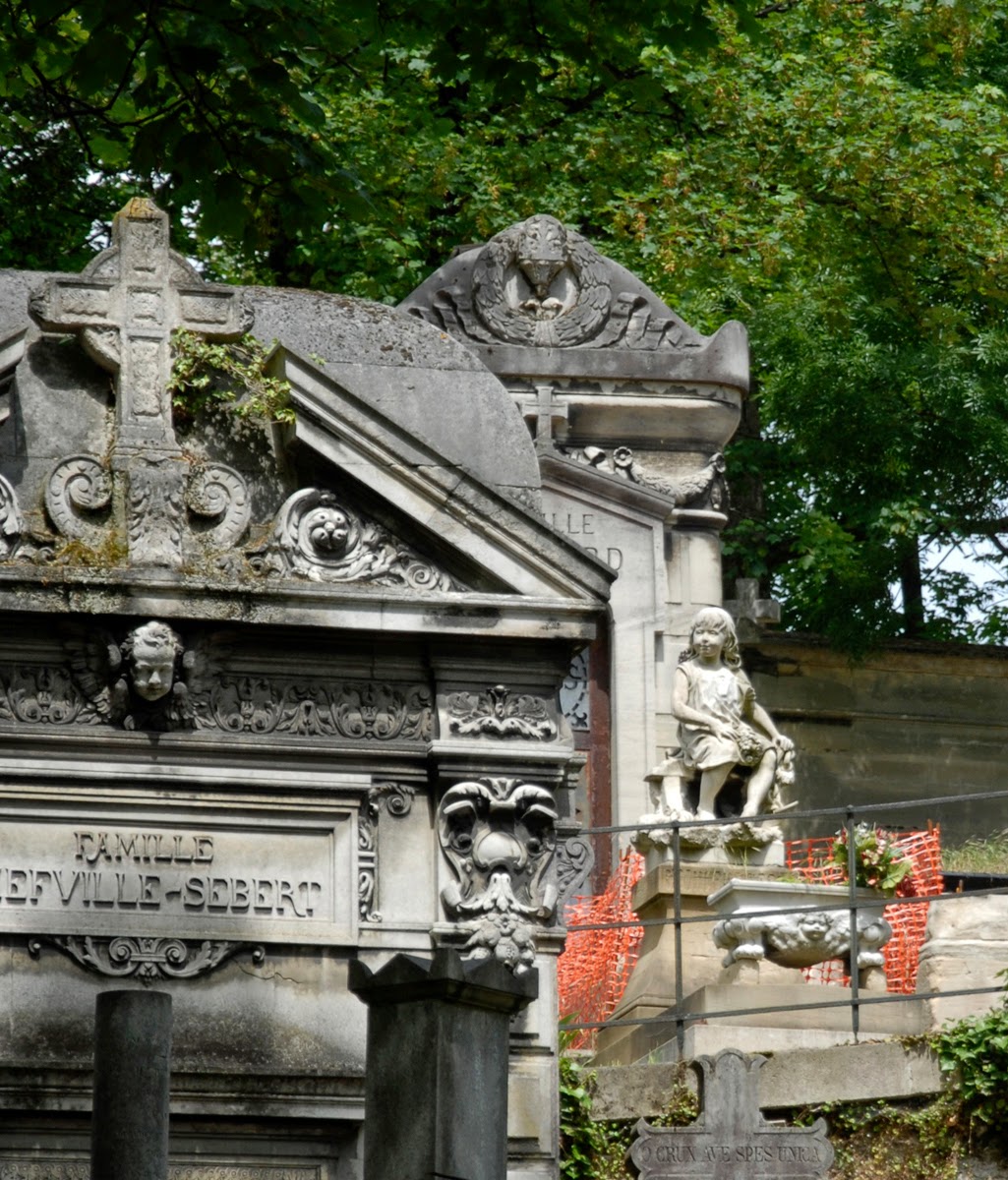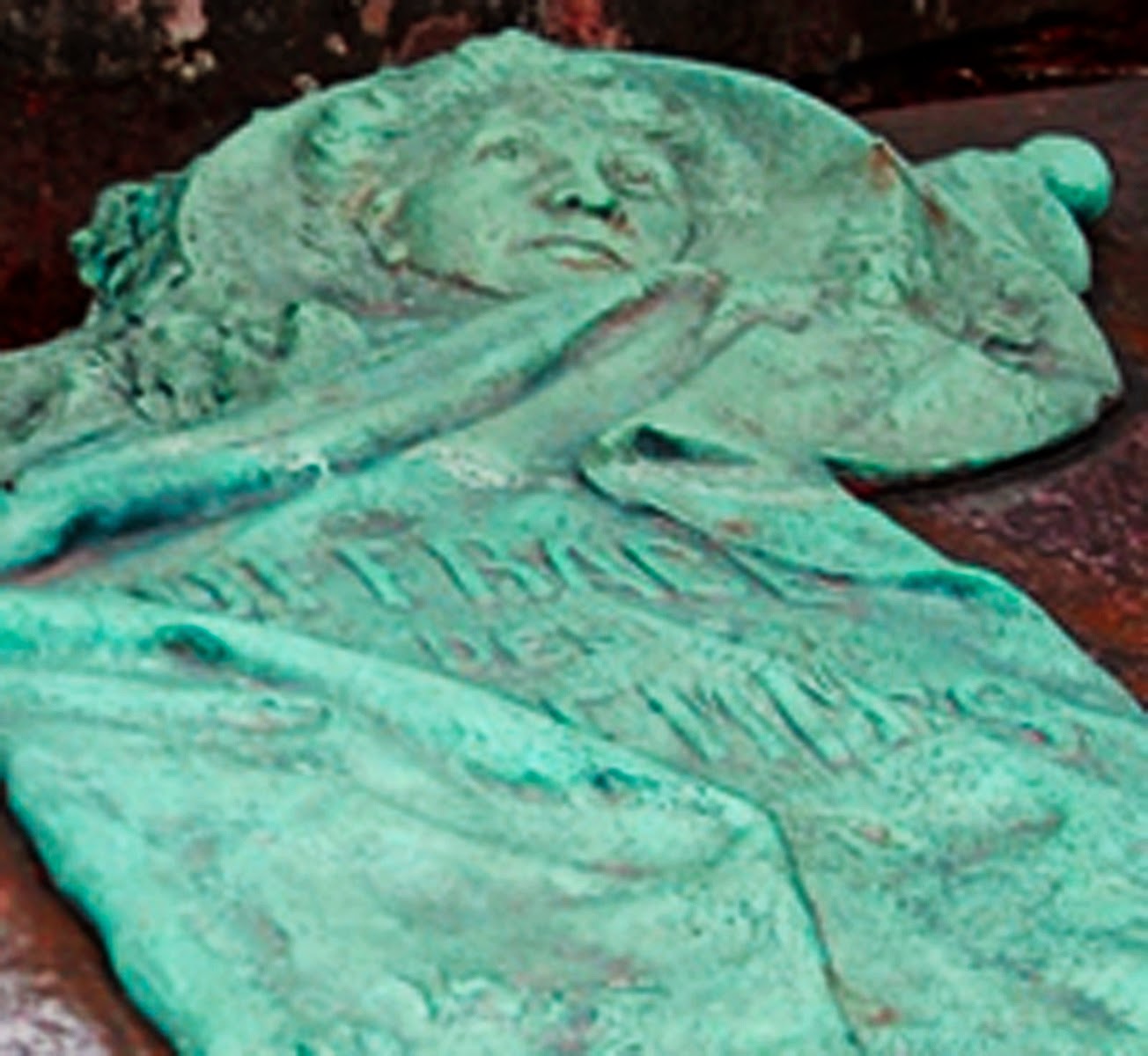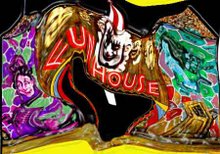So navigating the gigantic area of Père Lachaise in something of a feat of Hercules. There are blocks with numbers and even then finding the grave within that area can be quite challenging. Nonetheless the strong of heart can succeed with a little effort.
Perhaps it is the romantic in me, but the first grave I headed to was that of Heloise and Abelard.
There they were in all their gothic splendor transplanted into the early 19th century
Here is a closer view of Heloise.
This grave was to a music teacher. Being a teacher myself, I was touched that he was honored for his teaching and his love of music.
Of course the greatest number of people congregate around that famous non-Parisien, Jim Morrison. I've heard the cemetery would really like him out of there, but they would lose a lot of their aging (and thus wealthy) American tourists if they uprooted him.
I guess it's true, "No one here gets out alive."
This is the grave of Jacque Duclos, political leader of the 60s and 70s.
I wonder who puts the flowers on Chopin's grave? He seems to receive them constantly.
The grave in the foreground is that of Fauré, but the one behind it is really more interesting.
Below is the grave of Jean Jacques Rousseau. He was actually from Geneva, but many people of different nationalities have been honored with space here.
For fans of the Revolution here is the family crypt of Saint Simon.
This one is special to me, the resting place of Pierre Bourdieu. He theorized about class and the fact that the decision about what is art is made by the upper class and is not really a matter of innate taste.
Below is Paul Eluard. He was a surrealist poet and ambassador of the intellectual congress - a man who was much beloved and brought throngs of supporters to his funeral in Père Lachaise.
This was a monument to the resistance in the second world war. It is a mosaic with extraordinary movement of line.
This is the artist Modigliani. I'm glad he has a flower planter which means flowers on a regular basis.
This grave had a few people gathered around it too. It is the home of the little sparrow of France. When I arrived a busker on the train from the airport jumped into my car and began singing "la Vie en Rose" in a very Piaf-like way. It was a marvelous way to be welcomed to France. I guess I should have given her some money.
I have a soft spot for Georges Moustaki, the Greco-French singer of the 70s. Others must also feel this way as there were many flowers on his grave.
The following markers are memorials to the holocaust victims and victims of the second world war. They have beautiful pieces of art that are stark and disturbing.
I was finally getting to the upper end of the cemetery and was able to locate the grave of Oscar Wilde. It was pretty easy to find, since it was large and there were many admirers near it.
The memorial was paid for by an anonymous 2000 Pound donation (later revealed to be from Wilde's friend Ada Leverson). Jacob Epstein got his second sculptural commission to do the piece.
The sculpture was evidently modeled on the Assyrian Bulls in the British museum, but the size of the testicles offended the Paris police and not only did they refuse to accept it as art, but they also insisted it be covered.
When the sculptured was dedicated by poet Aleister Crowley (yes that Aleister Crowley) there was a bronze butterfly across the area, so Epstein refused to attend the ceremony. later he reputedly met Crowley at a cafe and Crowley was wearing a bronze butterfly around his neck when he reported that Epstein's work was now presentable. Oh for the days when people could be so easily scandalized!
They glassed in the tomb because too many people were putting on lipstick and kissing it. (I wonder how you decide what too many kisses is.) People had placed messages and flowers beneath the edge of the glass that were touchingly beautiful.
Another grave that had a serious and thoughtful visitor was this one.

There was a middle aged gentleman, whom I took to be an American Professor looking solemn and pensive as he stood over the grave of Marcel Proust. It seemed like a good idea, so after he left, I did the same. I've never much liked Madeleines, but Proust is indeed a stellar writer, definitely in the top ten of the twentieth century. I guess I'm not a serious enough writer to spend three years in a cork-lined room.
For another scandalous denizen of the place look below. This is Balzac's tomb. It really seems far too respectable somehow! (Not a testicle to be seen!)
I expected something much more (well, er...) dramatic for Sarah Bernhardt. I wonder if that coffin she travelled around with is in that tomb.
This is the crematorium.
This is a sweet sight - the graves of Yves Montand and Simone Signoret. Sleep well, la Condessa!
This is the tomb of the artist Eugene Delacroix.
And here is another artist Jean-Auguste-Dominique Ingres.
Now we get to the first famous transplant La Fontaine and next door...
Moliere.
The cemetery is huge and has several open spaces and boulevards (and would you believe it there's that silly tower again off in the distance center!)
This sculptural grave is in honor of a famous puppeteer. I guess in his day he was the equivalent of Joss Whedon or J.J Abrams, being a creator, producer and performer of popular entertainment.
Finally as I was levying I made sure to pass by the marker of Rossini's tomb. He along with a few other Italians have since departed for other resting places, but I still wanted to see his place. (I'm still mad that I missed Bizet!!)
And with that I decided to head off to see the final landmark of the day.








































































